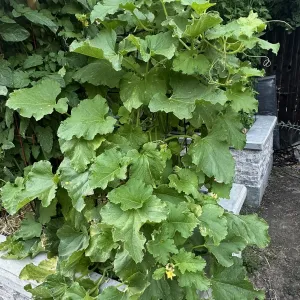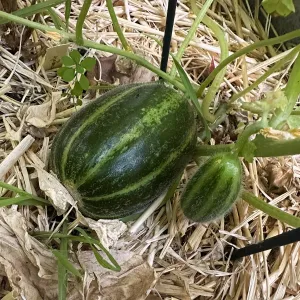Blog by Melinda Nestlerode
Last year, I was fortunate to attend a presentation by Jay Tracy of The Cucumber Shop, who gave each of the attendees a packet of 24 cucumber seeds. I chose a packet labeled “Carosello Leccese Striped”, because Jay said it was his all-time favorite cucumber. That meant a lot coming from someone who grows and tastes cucumbers for a living. What I did not realize at the time is that the seeds were not technically (biologically) cucumber seeds. Genetically, the Carosello Leccese is considered a Cucumis melo (C. melo), or cucumber-melon.

The cucumbers that most of us are familiar with are Cucumis sativus (C. sativus). They grow in different shapes and varying colors, but the most common ones are oblong, have dark green skin and a watery texture, and can be bitter and cause indigestion. C. sativus originated in the Indian subcontinent, and were introduced to Europe in the 9th century. Their tough green skin and adaptability to cooler temperatures enabled them to be transported and stored longer than C. melo, and they soon surpassed the cucumber-melon in popularity.
C. melo cucumber-melons are believed to originate from Ancient Egypt, and were grown in Africa and Europe prior to the introduction of C. sativus. They were a staple of kings and emperors. Fortunately, regional farmers in Puglia, southern Italy, continued to grow C. melo var. Carosello as a traditional heirloom crop. Puglia, located at the southeastern "heel" of Italy, has a rich agrobiodiversity heritage, thanks to its ancient farming traditions, diverse microclimates, and deeply rooted local food culture. The people grow small, diverse, heirloom crops, and use them seasonally in simple local food preparations that highlight the produce.
The Carosello Leccese cucumber-melon is listed in the global “Slow Foods Arc of Taste” catalogue, whose mission is the preservation of traditional, culturally significant, and endangered foods that are at risk of disappearing due to industrial agriculture, environmental degradation, and loss of local knowledge.
Other members of the C. melo family (commonly known as muskmelons) are honeydew, cantaloupe, and Casaba melon. Unfortunately, I won’t be able to harvest seeds from my Carosello plants because I am growing cantaloupe in the same raised bed. As they share the genus Cucumis, they can cross-pollinate, and the seeds may not duplicate the parent plant. Cucumber-melons are harvested when immature. Mature cucumber-melons are said to be inedible and useful only for seed.

I started my Carosello Leccese seeds in late February and transplanted them into organically rich, raised-bed soil in April. I’m also growing a more traditional cucumber: Cucumis sativus ‘Beit Alpha’, and the Carosello plants were comparatively slow to grow. However, once the weather warmed up, the plants took off. I try to harvest the fruit when it is 1 ½” to 2” in diameter, but like zucchini, blink, and fruit has doubled in size.
The Carosello Leccese thrives in our Mediterranean climate and appreciates fertile, well-drained soil. I fertilize with fish emulsion once per month. These cucumber melons are shorter and plumper than traditional cucumbers, with festive dark green stripes running lengthwise along their thin, edible skin. Their texture and aroma are similar to honeydew, but they are not at all sweet. They contain less water than a cucumber, and are quite delicious in traditional cucumber recipes, or eaten by themselves.

If you are looking for an interesting, tasty vegetable (technically a fruit) that flourishes during our hot summers, try this ancient variety of cucumber that is not a cucumber!

